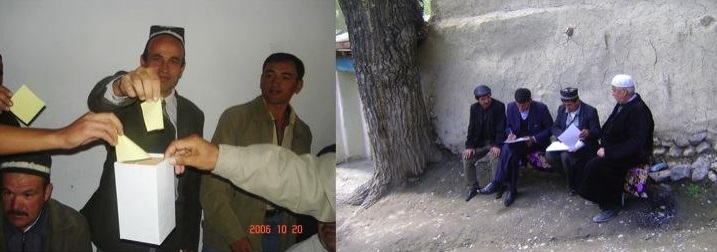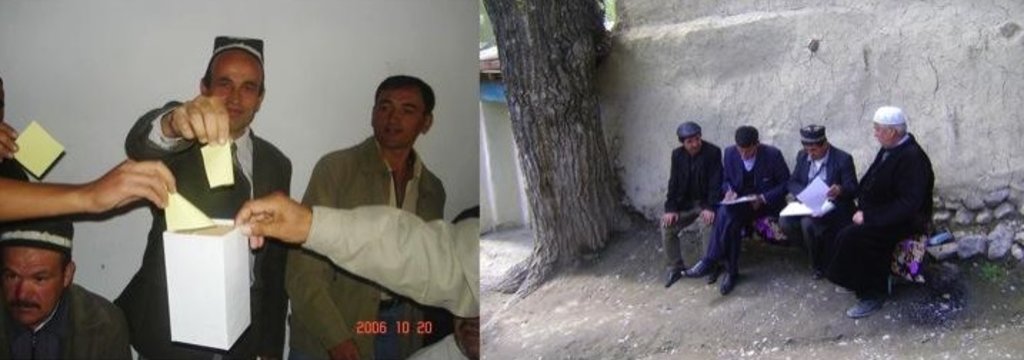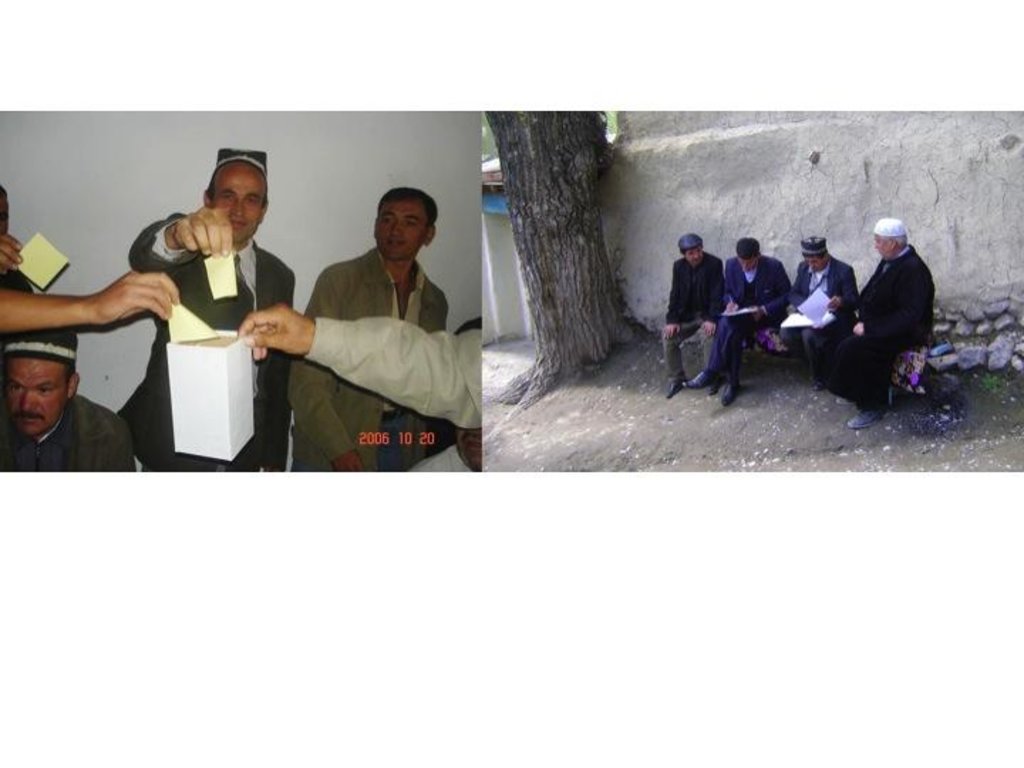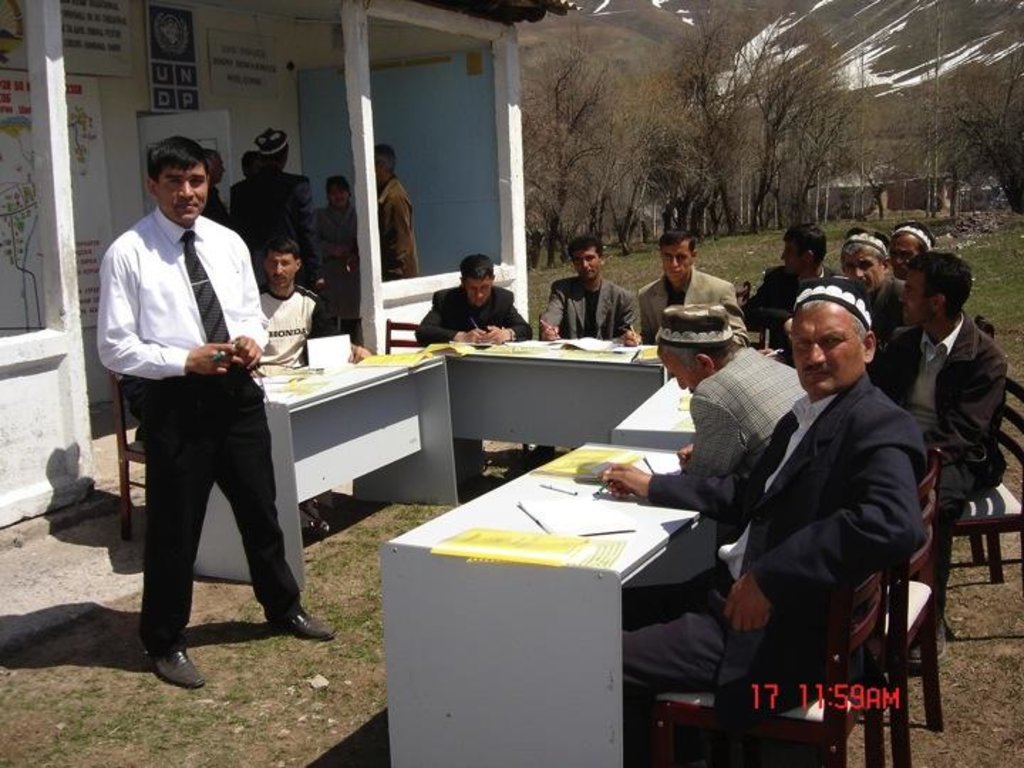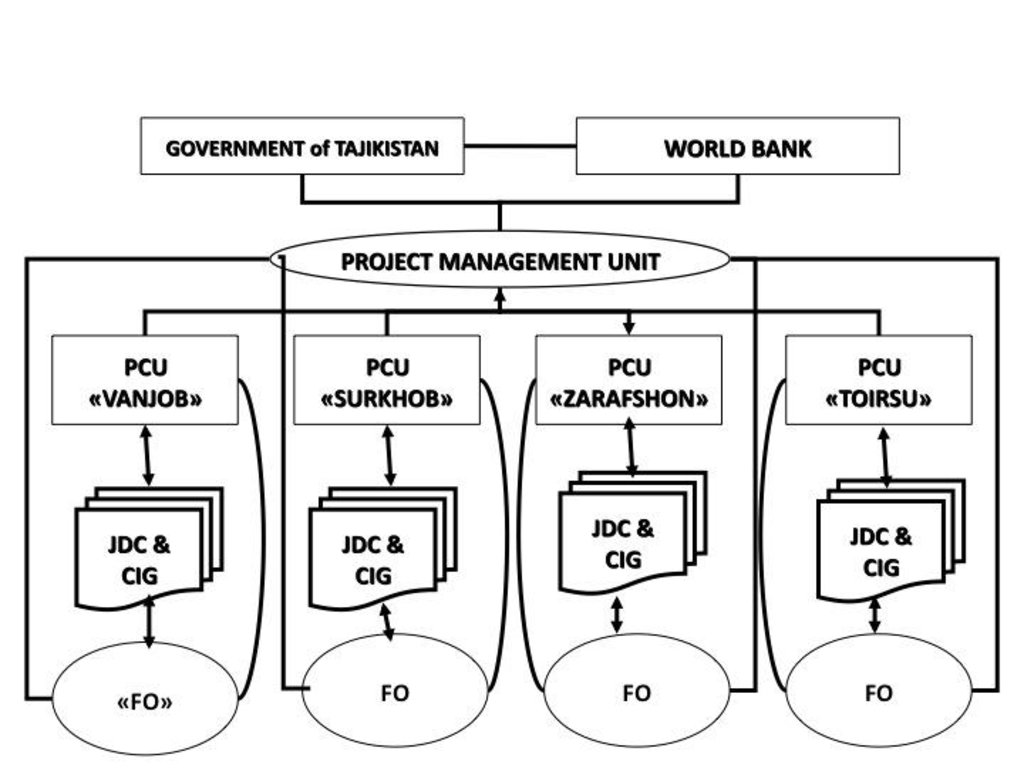Sub-district (Jamoat) level support for sustainable land management [Tadjikistan]
- Création :
- Mise à jour :
- Compilateur : Nandita Jain
- Rédacteur : –
- Examinateurs : David Streiff, Alexandra Gavilano, Joana Eichenberger
approaches_2446 - Tadjikistan
Voir les sections
Développer tout Réduire tout1. Informations générales
1.2 Coordonnées des personnes-ressources et des institutions impliquées dans l'évaluation et la documentation de l'Approche
Spécialiste GDT:
Mott Jessica
World Bank
Etats-Unis
Nom du projet qui a facilité la documentation/ l'évaluation de l'Approche (si pertinent)
Pilot Program for Climate Resilience, Tajikistan (WB / PPCR)Nom du ou des institutions qui ont facilité la documentation/ l'évaluation de l'Approche (si pertinent)
World Bank (World Bank) - Etats-Unis1.3 Conditions relatives à l'utilisation par WOCAT des données documentées
Quand les données ont-elles été compilées (sur le terrain)?
20/10/2006
Le compilateur et la(les) personne(s) ressource(s) acceptent les conditions relatives à l'utilisation par WOCAT des données documentées:
Oui
2. Description de l'Approche de GDT
2.1 Courte description de l'Approche
Provision of technical and financial management assistance through Jamoat (“Sub-District”) level organizations to farmers in a large small grants programme.
2.2 Description détaillée de l'Approche
Description détaillée de l'Approche:
Aims / objectives: The Tajikistan - Community Agriculture & Watershed Management Project (CAWMP), aimed to use a sub-district level organization to provide more efficient, transparent and accountable services to farmers for the project duration. CAWMP financed small grants to farmer groups for agricultural production in environmentally sustainable ways in Tajikistan’s uplands. The sub-district level support for this initial six year period, together with support from other project partners, helped (a) enable project implementation, and (b) build farmer capacity to sustain the investments after the end of six-year project, even in the absence of continued outside support.
Methods: In four project sites 39 Jamoat (“sub-district”) Development Committees (JDCs) operated as NGOs with elected officers and helped organize 43,000 households into groups to implement 4,000 rural production investments that included varied SLM technologies in 402 villages. JDCs managed $7.4 million in small grants. Use of the JDC built upon existing initiatives to strengthen local governance. The JDCs collaborated and received support from a government-appointed Project Management Unit (PMU), field-based Project Coordination Units (PCUs), and four contracted Facilitating Organizations (FOs). These partners helped train JDCs in financial, organizational, and technical aspects (e.g. fund flow, participatory planning, SLM technologies), and assisted villages to form new JDCs where none existed.
Stages of implementation: JDCs, with FOs and PCU specialists, undertook activities including: 1) preparation of participatory village-based Community Action Plans (CAPs) that included proposed rural production investments and formation of Common Interest Groups (CIGs) of households [See TAJ046}; 2) participation in sub-district and project-site/watershed level screening and approval of rural production proposals from CIGs to ensure economic, environmental and social feasibility [See TAJ045]; 3) management and disbursement of grant funds from the PMU to CIGs [See TAJ 044]; 4) overseeing formal investment agreements with participating CIGs; 5) monitoring, evaluation and reporting; and 6) liaison with other villages and relevant government agencies to facilitate permissions, resource use agreements, issuance of land use rights, etc.
Role of stakeholders: JDCs comprised elected village representatives and the government’s sub-district officials. Generally, JDC members have relatively higher levels of education and relevant knowledge and experience than the local population. A JDC chairperson and secretary were elected and a qualified accountant/bookkeeper appointed. JDCs met monthly and established committees, (e.g., gender, environment, financial management and social). CAWMP paid an honorarium for the accountant and incremental travel costs for all JDCs. For newly established JDCs, CAWMP also provided funds for office facilities, plus an honorarium for the chairperson, and an additional honorarium for another officer if one was female.
2.3 Photos de l'approche
2.5 Pays/ région/ lieux où l'Approche a été appliquée
Pays:
Tadjikistan
Région/ Etat/ Province:
Sughd, Khatlon, RSS, GBAO
Autres spécifications du lieu :
7 districts and 39 sub-districts
Commentaires:
As part of the Commnunity Agriculture and Watershed Management Project, the approach was implemented in Jirgital, Tajikibad, Vanj, Aini, Matcha, Penjikent, Danghara districts, in 4 regions. Four project sites/watersheds - Surkhob, Vanjob, Zarafshan and Toirsu - were included in the The total catchment area was 35,000km2. Total arable, farm and pasture land was approximately 319,500ha
Map
×2.6 Dates de début et de fin de l'Approche
Indiquez l'année de démarrage:
2005
Date (année) de fin de l'Approche (si l'Approche n'est plus appliquée):
2012
2.7 Type d'Approche
- fondé sur un projet/ programme
2.8 Principaux objectifs de l'Approche
The Approach focused mainly on other activities than SLM (Sub-district assistance, non-government organizations, farmer groups, facilitation support, technical advice, fund transfers to farmer groups, )
Efficient and responsible sub-district institutional arrangements for a fixed-term project that are able to assist upland farmers in adopting practices to increase agricultural production in sustainable ways.
The SLM Approach addressed the following problems: Use of sub-district organizations provided an efficient, transparent and accountable way of providing essential services to farmers for the period of initial investment, i.e., the six-year period of project implementation. Alternatives ways of providing this support would have had disadvantages: such support at a village level would have been too expensive and faced human capacity constraints, while using the centralized government system or relying solely on large NGOs would have been less transparent, less participatory, and less accountable to the interests of local people.
2.9 Conditions favorisant ou entravant la mise en œuvre de la(des) Technologie(s) appliquée(s) sous l'Approche
disponibilité/ accès aux ressources et services financiers
- entrave
Poor transparency and accountability in financial transactions between government and farmers in rural development. Upland farmers lacked financial capital.
Treatment through the SLM Approach: JDC support services for managing about 4000 small grants, including participatory planning and streamlined fund transfers from PMU to farmer groups through JDCs.
cadre institutionnel
- entrave
Limited financial and technical resources for upland agriculture given government focus on lowland crop, especially cotton, production. Remoteness restricts access to available services.
Treatment through the SLM Approach: Access to technical and financial services through establishment and capacity building of 39 JDCs in upland areas.
cadre juridique (régime foncier, droits d'utilisation des terres et de l'eau)
- entrave
Slow issuance of land use rights certificates for upland family farms - poor incentives to invest household assets and adopt SLM practices. No rights allocation for horticulture, woodlots and other uses with restricted access on sloping lands.
Treatment through the SLM Approach: Legal agreements governing CAWMP permitted issuance of certificates (including for sloping lands) to project participants on the basis of adopting SLM practices.
The existing land ownership, land use rights / water rights hindered a little the approach implementation Very few Land Use Rights Certificates had been issued at start of project for arable land in upland areas. There was no provision for allocation of use rights to non-arable sloping lands suitable for horticulture, woodlots and other restricted access uses.
connaissances sur la GDT, accès aux supports techniques
- entrave
Lack of technical capacity among farmers in participatory processes and SLM technologies and methods.
Treatment through the SLM Approach: Extensive training for JDCs in order to assist farmers. Trainings for local government specialists to facilitate local approvals for CIG activities.
3. Participation et rôles des parties prenantes impliquées dans l'Approche
3.1 Parties prenantes impliquées dans l'Approche et rôles
- exploitants locaux des terres / communautés locales
JDCs registered as non-profit, non-government organisations
Most JDCs had women members, but overall levels of female participation were less than 25%. Social and cultural circumstances, especially in the more remote upland areas, place restrictions on the extent to which women can actively participate in organisations such as JDCs. Among the four project sites, there were also differences in the number of women represented in JDCs
There was some representation in JDCs of poor, vulnerable households, as well as single female-headed households
- ONG
International NGOs: Welthungerhilfe, Aga Khan Foundation/Mountain Societies Development Support Programme
- gouvernement national (planificateurs, décideurs)
Project Management Unit, Project Coordination Units
- organisation internationale
UNDP-Tajikistan, FAO-Tajikistan
3.2 Participation des exploitants locaux des terres/ communautés locales aux différentes phases de l'Approche
| Participation des exploitants locaux des terres/ communautés locales | Spécifiez qui était impliqué et décrivez les activités | |
|---|---|---|
| initiation/ motivation | aucun | |
| planification | passive | Local communities consulted for social assessment during project design. |
| mise en œuvre | interactive | JDC members (village representatives) provided a range of services to villagers and other functions such as liaison with government for the purposes of CAWMP. |
| suivi/ évaluation | interactive | JDCs and CIGs were signatories of formal agreements governing grants for rural production. JDCs released funds based on agreed benchmarks and with PCUs and FOs monitored and reported on environmental, economic and social aspects. |
| Research | aucun |
3.3 Diagramme/ organigramme (si disponible)
Description:
Implementation Arrangements for Community Agriculture and Watershed Management Project
Auteur:
Project Management Unit (Dushanbe, Tajikistan)
3.4 Prises de décision pour la sélection de la Technologie/ des Technologies
Indiquez qui a décidé de la sélection de la Technologie/ des Technologies à mettre en œuvre:
- principalement les exploitants des terres soutenus par des spécialistes de la GDT
Expliquez:
CIG members and technical specialists made decisions on the choice of SLM technologies in any one small grant proposal. Within each JDC, the entire committee made decisions on acceptable proposals, with a technical committee often conducting the initial screening. On obtaining JDC approval, proposals were submitted for further review by a regional Watershed Devlelopment Committee
Decisions on the method of implementing the SLM Technology were made by mainly by land users supported by SLM specialists. CIG members and technical specialists from the respective facilitating organisation and the project coordination unit made decisions on the method/s for implementing SLM technologies in any one proposal. However, CIGs undertook full responsibility for the implementation and management of the rural production investments.
4. Soutien technique, renforcement des capacités et gestion des connaissances
4.1 Renforcement des capacités/ formation
Une formation a-t-elle été dispensée aux exploitants des terres/ autres parties prenantes?
Oui
Spécifiez qui a été formé:
- exploitants des terres
- personnels/ conseillers de terrain
- JDCs
Formats de la formation:
- sur le tas
- entre agriculteurs (d'exploitants à exploitants)
- zones de démonstration
- réunions publiques
Thèmes abordés:
Organisational Management, Book-keeping, Participatory rural appraisal, Participatory environmental planning and analysis, a range of SLM technologies, monitoring and evaluation, gender awareness.
4.2 Service de conseils
Les exploitants des terres ont-ils accès à un service de conseils?
Oui
- informal information
Décrivez/ commentez:
Informal advice and facilitation support by JDCs, in collaboration with other project partners: Key elements: Project design and procedures, Technical, financial and institutional considerations of proposed investments for grant financing, fostering increased knowledge and changes in attitudes and practices among farmers to identify advice needed, and for ongoing learning during the post project period.;
Nominal government advisory services exist at district level, and even less in sub-districts. Technical capacities for SLM are lacking. Staff are poorly paid, positions are unfilled and finances are inadequate. Little orientation toward client service and governance problems are common. Conditions unlikely to change in foreseeable future. JDCs and project partners provided informal advisory services during investment period, created demand among farmers to seek advice in post-project period.
See comments in 2.4.2.1. for information on government advisory services
4.3 Renforcement des institutions (développement organisationnel)
Des institutions ont elles été mises en place ou renforcées par le biais de l'Approche?
- oui, beaucoup
Spécifiez à quel(s) niveau(x), ces institutions ont été renforcées ou mises en place:
- local
Précisez le type de soutien:
- financier
- renforcement des capacités/ formation
- équipement
Donnez plus de détails:
Support of sub-district local institutions is the focus of the Approach.
4.4 Suivi et évaluation
Le suivi et l'évaluation font ils partie de l'Approche? :
Oui
Commentaires:
management of Approach aspects were None monitored by project staff through observations; indicators: Quality of CIG proposals and implementation, rate of fund disbursement to CIGs, timeliness of report
There were few changes in the Approach as a result of monitoring and evaluation: Poor initial attention to environmental aspects of SLM and other investments in CIG proposals led to increased training for JDCs, FOs, PMU, PCU and local government officials in participatory environmental analysis.
There were few changes in the Technology as a result of monitoring and evaluation: Based on field observations and measurements in some cases, CIGs with the assistance of JDCs, FOs and project staff adjusted various SLM technologies that had been implemented as part of rural production investments during the course of implementation, e.g., composting procedures, irrigation techniques.
4.5 Recherche
La recherche a-t-elle fait partie intégrante de l’Approche?
Oui
- Project evaluations
Donnez plus de détails et indiquez qui a mené ces recherches:
While the JDCs did not directly carry out formal research, they participated as respondents in the project evaluations that were carried out by the NGOs, and the PMU. These evaluations included findings from a variety of stakeholder perspectives about the JDC involvement.
5. Financement et soutien matériel externe
5.1 Budget annuel de la composante GDT de l'Approche
Si le budget annuel précis n'est pas connu, indiquez une fourchette:
- > 1 000 000
Commentez (par ex. principales sources de financement/ principaux bailleurs de fonds):
Approach costs were met by the following donors: local government (district, county, municipality, village etc) (Opportunity cost of government officials’ time): 5.0%; international non-government (Estimate of co-financing ): 5.0%; government (Estimate of co-financing ): 90.0%; international (World Bank/International Development Assistance and Global Environment Facility); local community / land user(s) (Opportunity cost of land users’ time); other (Opportunity cost of JDC members’ time )
5.2 Soutiens financiers/ matériels fournis aux exploitants des terres
Les exploitants des terres ont-ils reçu un soutien financier/ matériel pour la mise en œuvre de la Technologie/ des Technologies?
Non
5.4 Crédits
Des crédits ont-ils été alloués à travers l'Approche pour les activités de GDT?
Non
6. Analyses d'impact et conclusions
6.1 Impacts de l'Approche
Est-ce que l'Approche a aidé les exploitants des terres à mettre en œuvre et entretenir les Technologies de GDT?
- Non
- Oui, un peu
- Oui, modérément
- Oui, beaucoup
Providing sub-district-level support was critical for implementing almost 4000 rural production investments that integrated SLM practices into the management of over 96,000ha.
Est-ce que l'Approche a autonomisé les groupes socialement et économiquement défavorisés?
- Non
- Oui, un peu
- Oui, modérément
- Oui, beaucoup
JDCs helped target vulnerable groups during community mobilization and preparation of CAPs. Women comprised 40% of project participants benefiting from rural production investments.
Est-ce que l'Approche a amélioré les questions foncières et des droits d'utilisation qui entravent la mise en œuvre des Technologies?
- Non
- Oui, un peu
- Oui, modérément
- Oui, beaucoup
Legal agreement for CAWMP permitted issuance of use rights certificates for sloping lands for horticulture, woodlots and other restricted access uses based on adoption of SLM practices. JDCs assisted project staff in processing certificates for participating households, linking farmers, project staff and government officials. Another project accelerated issuance of arable land certificates.
Did other land users / projects adopt the Approach?
- Non
- Oui, un peu
- Oui, modérément
- Oui, beaucoup
JDCs existed prior to the project, and CAWMP built upon this arrangement. Institutions similar to JDCs continue to be supported in some regions of the country. However, in accordance with the CAWMP design and the initial risk assessment, land users who have received CAMWP-financed grants are not necessarily dependent on the sustainability of JDC support during the post project period. These farmers should have the capacity, incentives, and the responsibility to sustain their investments.
Did the Approach lead to improved livelihoods / human well-being?
- Non
- Oui, un peu
- Oui, modérément
- Oui, beaucoup
An overall project assessment indicates that about 80% of investments implemented with the support of JDCs and other project partners, and in conjunction with other project activities are successful.
Did the Approach help to alleviate poverty?
- Non
- Oui, un peu
- Oui, modérément
- Oui, beaucoup
As part of the CAWMP, the approach contributed to increasing the proportion of people above poverty from 3% to 20% in the participating villages (to be updated with 2011 evaluation data).
6.2 Principale motivation des exploitants des terres pour mettre en œuvre la GDT
- augmenter la production
potentially more sustainable production
- affiliation à un mouvement/ projet/ groupe/ réseaux
availability of investment capital, technical assistance
- well-being and livelihoods improvement
opportunity to increase livelihood assets
6.3 Durabilité des activités de l'Approche
Les exploitants des terres peuvent-ils poursuivre ce qui a été mis en œuvre par le biais de l'Approche (sans soutien extérieur)?
- oui
Si oui, décrivez de quelle manière:
In accordance with the CAWMP design and the initial risk assessment, land users who have received CAMWP-financed grants are not necessarily dependent on the sustainability of JDC support during the post project period. These farmers should have the capacity, incentives, and the responsibility to sustain their investments on their own during the post-project period.
6.4 Points forts/ avantages de l'Approche
| Points forts/ avantages/ possibilités du point de vue de l'exploitant des terres |
|---|
| To be added based on project evaluation due in late 2011 |
| Points forts/ avantages/ possibilités du point de vue du compilateur ou d'une autre personne ressource clé |
|---|
| Scale and scope of JDC mandates is effective for delivering services to upland, and often remote, farmers. (How to sustain/ enhance this strength: Maintain a focus on strengthening sub-district level support to farmers.) |
| Sub-district level organisations can be an effective component of scaling-up strategies for SLM in a challenging physical landscape. (How to sustain/ enhance this strength: Scaling-up strategies will require investment in institutional arrangements.) |
| Participatory processes help ensure that organisations such as JDCs can work effectively with government units to deliver technical and financial resources to farmers. (How to sustain/ enhance this strength: Ensure that participatory processes, including financial management mechanisms, are well integrated into SLM programmes.) |
6.5 Faiblesses/ inconvénients de l'Approche et moyens de les surmonter
| Faiblesses/ inconvénients/ risques du point de vue du compilateur ou d'une autre personne ressource clé | Comment peuvent-ils être surmontés? |
|---|---|
| Uncertain financial sustainability of JDCs during the post-project period in the absence of donor funding. | 1. Continue to emphasize the importance of farmers having the capacity, incentives, and the responsibility to sustain their investments on their own, in the event that ongoing support from JDC is not available post-project. 2. Until more sustainable jamoat-level support system is established and proven to be effective in Tajikistan (i.e., meeting transparent, accountable, efficient, and capacity requirements), clarify fixed term nature of JDC support in order to avoid misunderstandings and unrealistic expectations. 3. Highlight JDC functions for the fixed term (6 years) under CAWMP and explore opportunities to include similar functions in current efforts of other donors to establish sub-district representative government bodies. |
7. Références et liens
7.2 Références des publications disponibles
Titre, auteur, année, ISBN:
Operational Manual for Community Mobilization, Rural Production Investments and Research and Demonstrations Grants (2008)
Titre, auteur, année, ISBN:
Operational Manuals for JDCs and CIGs in Financial Management and Procurement (2007)
Titre, auteur, année, ISBN:
CAWMP: Project Appraisal Document (2005)
Liens et modules
Développer tout Réduire toutLiens
Aucun lien
Modules
Aucun module trouvé


